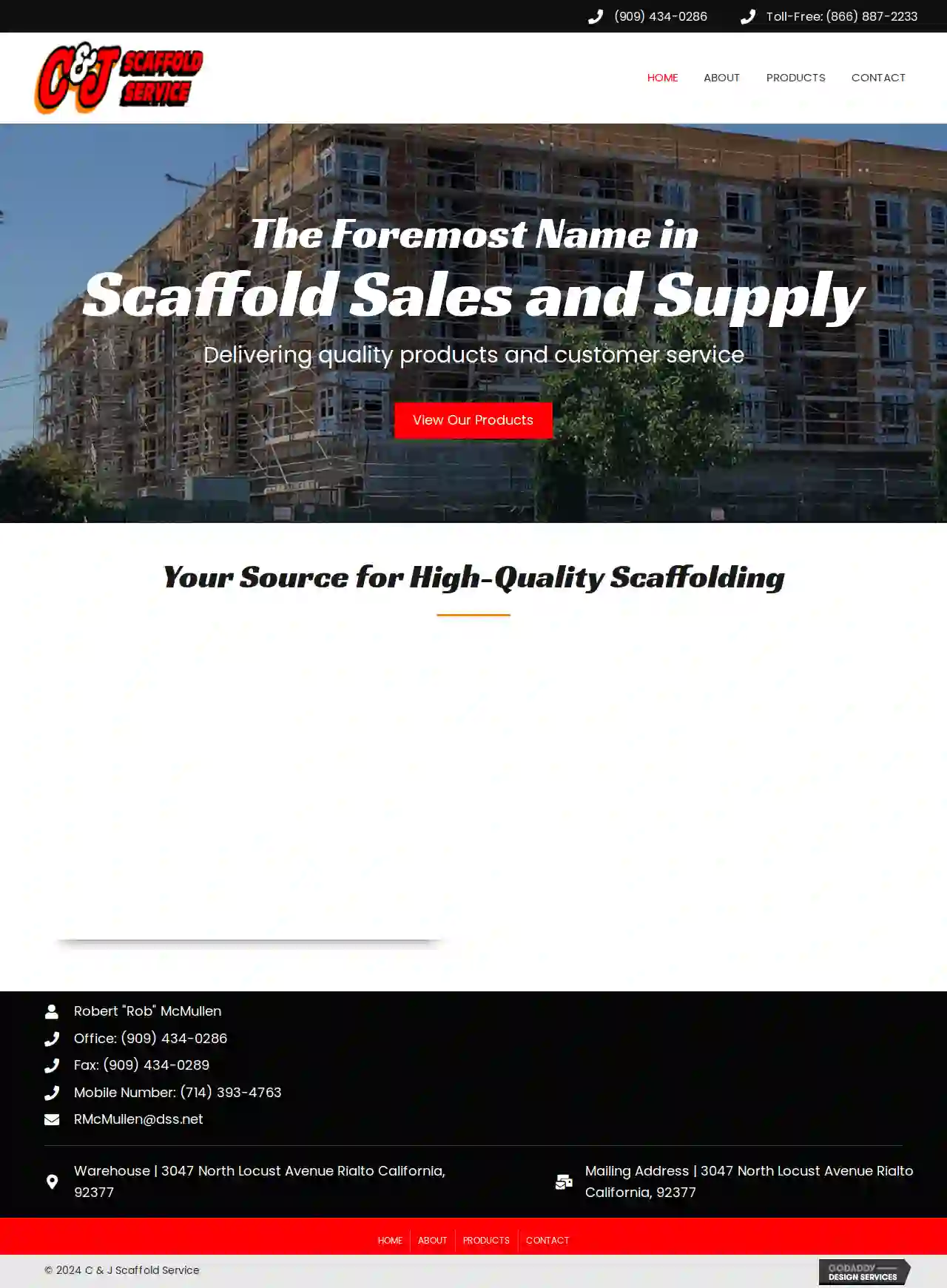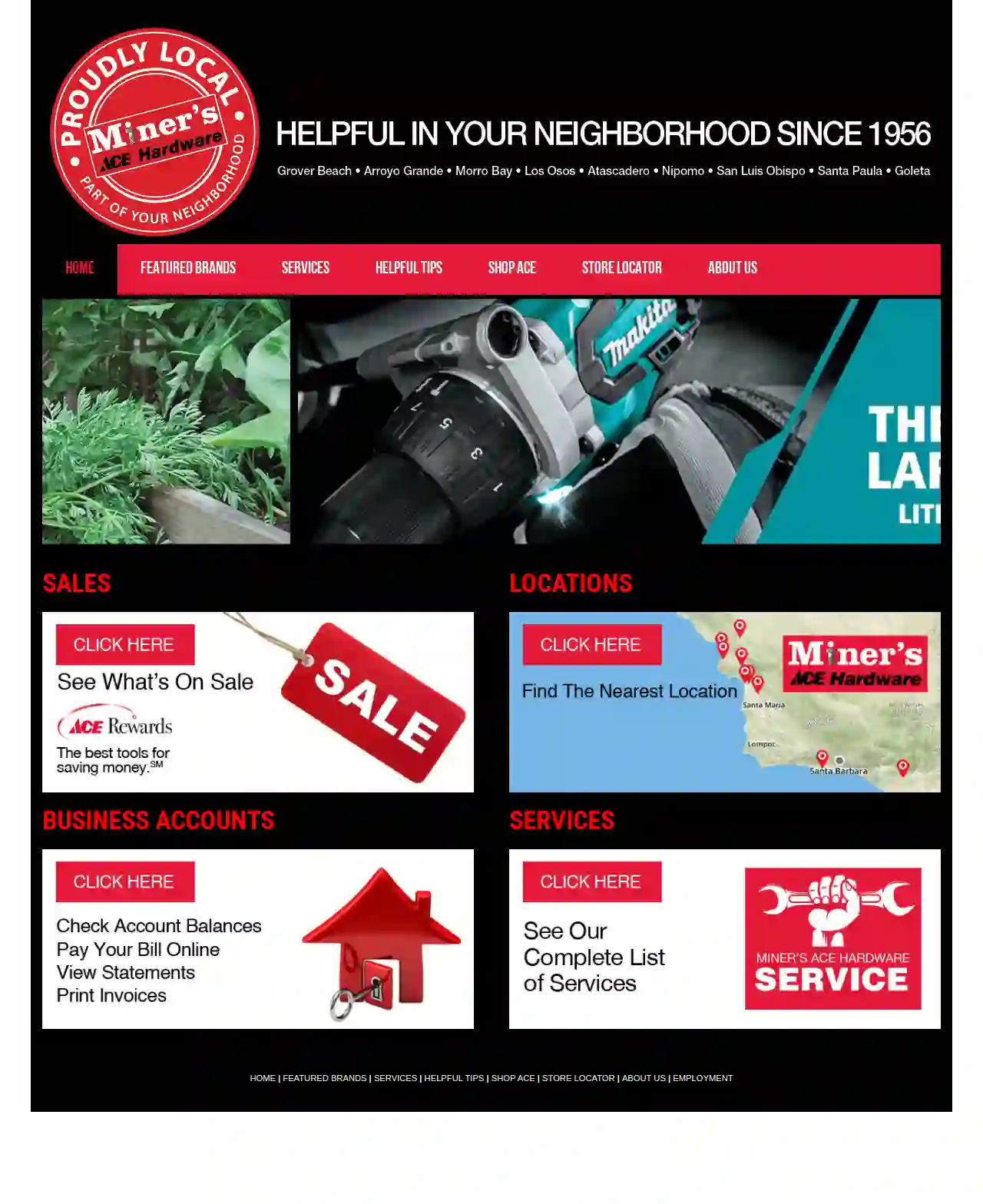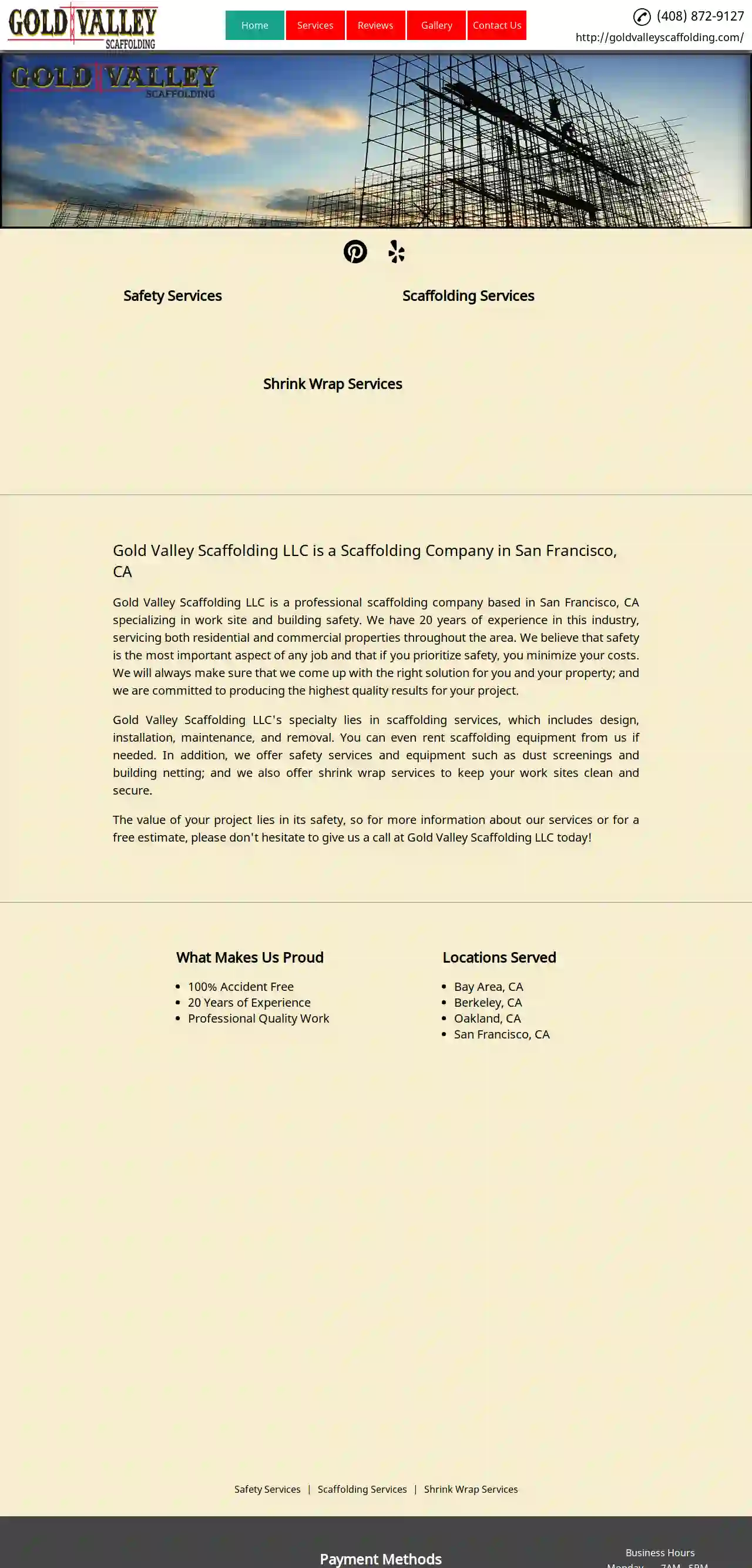Scaffolding Companies Cypress
Find the best Scaffolding Companies in Cypress
Receive up to 3 Scaffolding Specialists quotes for your project today! Compare profiles, reviews, accreditations, portfolio, etc... and choose the best offer.

DIRECT SCAFFOLD SUPPLY
4.811 reviews3047 North Locust Avenue, Rialto, 92377, USWelcome to C & J Scaffold Service, the foremost name in scaffold sales and supply of all scaffolding-related products. With over 50 years of combined sales and technical experience in the scaffolding industry, we strive to provide you with the best in commercial-grade products, competitive pricing, and unmatched service and reliability. Our goal is to make sure your scaffolding needs are met and you are able to complete your project safely and with the best of equipment. We offer a full line of scaffolding and accessories, including scaffolding frames, cross braces, guard rail, guard posts, safety gates, base plates, screw jacks, folding trestles, extensions, tuffy jacks, flat backs, rolling scaffold units, aluminum hook plank, hatch decks, laminated and southern yellow pine plank, MFS scaffolding products, pins, casters, wheels, pulleys, manufacturing parts, locking devices, side brackets, safety signage and stickers, veneer frames, steel tubing, stairways, ladders and brackets, post shores, debris and safety tarps/netting, trash chutes, and systems scaffolding products to include ring lock, cup lock, and tube lock styles.
- Services
- Why Us?
- Accreditations
- Our Team
- Gallery
Get Quote
D L Scaffolding Inc
54 reviewsSan Rafael, USAt DL Scaffolding Inc, we provide safe, high-quality, and timely scaffold services to our clients in the San Francisco Bay Area and beyond. With a strong focus on trust, integrity, dependability, efficiency, detail-orientedness, and timeliness, we strive to deliver exceptional results that meet our clients' specific project needs. Our team of experts offers a range of services, including scaffold design and planning, scaffold erection, scaffold dismantling, scaffold rental, deliver and pick-up, and project management. We take pride in our ability to provide end-to-end scaffold services that ensure on-time completion and adherence to safety standards.
- Services
- Why Us?
- Gallery
Get Quote
Ready Equipment Rental Inc.
421 reviews3969 N Sierra Way, San Bernardino, 92405, USAt Ready Equipment Rental, we have been providing our customers in the greater San Bernardino - Riverside Counties with an extensive variety of quality equipment rentals and tool rentals since 1988. From floor sanders to tile saws, utility trailers to tillers, tractors and bobcats to pressure washer's, we have the rental equipment and tools you need to build, maintain, power, move, or clean your projects. We are family owned, conveniently located at 3969 N Sierra Way, in San Bernardino Just north of the 210 Freeway and Waterman ave. We are here to help anyway we can for all your equipment rental and tool rental needs. Ask us about our affordable delivery and pickup, new and used equipment for sale.
- Services
- Why Us?
- Gallery
Get Quote
United Scaffold, Inc.
San Diego, USUnited Scaffold Inc. specializes in providing a wide range of scaffolding solutions, including frame scaffolding, modular scaffolding, and shrink wrap containment. They also offer temporary stairtower systems for safe and efficient egress to all levels and heights, conforming with Cal-OSHA's safety guidelines for emergency access. Additionally, they provide overhead protection canopy systems to ensure pedestrian and worker safety, and can assist in procuring traffic control and encroachment permits. Their steel and wood heavy-duty debris trash chutes are designed for moving materials efficiently and safely.
- Services
- Why Us?
- Gallery
Get Quote
Miner's Ace Hardware
4.4344 reviewsSan Diego, USMiner's Ace Hardware: A Family Legacy of Service Miner's Ace Hardware is a family-owned business with a rich history dating back to 1956. Founded by brothers Lee and Glenn Miner, the company began as a small hardware store in Grover Beach, California. Driven by a commitment to hard work and customer satisfaction, the brothers built a thriving business, expanding their operations over the years to serve the Central Coast community. In 1972, Miner's joined Ace Hardware, a buying co-op that allowed them to leverage the buying power of thousands of independent dealers. This strategic alliance enabled Miner's to remain competitive and offer a wide range of products at competitive prices. Under the leadership of Mike Miner, Lee's son, the business experienced significant growth and expansion. New locations were opened in Arroyo Grande, Morro Bay, Los Osos, Atascadero, Nipomo, San Luis Obispo, Santa Paula, and Goleta, bringing the Miner's Ace Hardware experience to more communities. Today, Miner's Ace Hardware continues to be a family-owned business, guided by the same values of hard work, customer service, and community involvement that were instilled by its founders. The company is committed to providing its customers with a wide selection of products, expert advice, and friendly service.
- Services
- Why Us?
- Gallery
Get Quote
Power Scaffold Service
4.52 reviews157 East Terrance Way, Bakersfield, 93307, USAt Power Scaffold Services, we build long-lasting relationships with our clients by working closely with them to understand and anticipate their needs. We provide cost-effective solutions that enable our clients to complete their projects safely, on-time, and according to plan. Our top-notch, versatile team has erected and dismantled scaffolds for hospitals, theaters, restaurants, oil refineries, power plants, chemical plants, cement plants, and water treatment plants using our state of the art, long-lasting, and durable Cup-Lock Scaffold System.
- Services
- Why Us?
- Accreditations
- Gallery
Get Quote
BrandSafway Services San Diego
4.622 reviews123 Main St, San Diego, CA, 92101, USBrandSafway is a leading provider of access solutions, including scaffolding, aerial work platforms, and forming and shoring equipment. With a strong commitment to safety, quality, and customer satisfaction, BrandSafway offers comprehensive solutions tailored to meet the unique needs of clients across various industries. Their team of experienced professionals works closely with clients to understand their requirements and deliver customized solutions that enhance efficiency, productivity, and safety on site. BrandSafway's mission is to provide innovative access solutions that help clients achieve their goals while maintaining the highest standards of safety and quality.
- Services
- Why Us?
- Accreditations
- Our Team
- Testimonials
Get Quote
BrandSafway Services Benicia
4.25 reviewsVallejo, USBrandSafway is a leading provider of access solutions, including scaffolding, aerial work platforms, and forming and shoring. With a strong commitment to safety, quality, and customer satisfaction, BrandSafway delivers innovative solutions to meet the unique needs of clients across various industries. Their team of experts works closely with clients to understand their requirements and provide tailored solutions that enhance efficiency, productivity, and safety on site. BrandSafway's mission is to provide exceptional service, quality, and safety to their clients, ensuring successful project outcomes.
- Services
- Why Us?
Get Quote
Gold Valley Scaffolding LLC
51 reviews123 Main St, San Francisco, CA, 94124, USGold Valley Scaffolding LLC is a professional scaffolding company based in San Francisco, CA specializing in work site and building safety. We have 20 years of experience in this industry, servicing both residential and commercial properties throughout the area. We believe that safety is the most important aspect of any job and that if you prioritize safety, you minimize your costs. We will always make sure that we come up with the right solution for you and your property; and we are committed to producing the highest quality results for your project.
- Services
- Why Us?
- Accreditations
- Our Team
- Testimonials
Get Quote
OLYMPIQUE Scaffold Inspection and Testing
3.73 reviews26429 Rancho Parkway South, Suite 145, Lake Forest, 92630, USOLYMPIQUE Facade Access Consulting is a leading provider of facade access consulting services, including new construction consulting and design, existing building consulting and design, and scaffold inspection and testing. With years of experience in the industry, our team of experts is dedicated to providing top-notch services to our clients. We are fully accredited and insured, and we maintain a Cal/OSHA SIT License No. 36. Our services are designed to meet the needs of building owners, contractors, and maintenance vendors, and we are committed to providing the highest level of quality and safety in everything we do.
- Services
- Why Us?
- Accreditations
- Gallery
Get Quote
Over 2,353+ Scaffolding Businesses registered
Our scaffolding contractors operate in Cypress and surroundings!
ScaffoldingHQ has curated and vetted Top Scaffolding Companies in and around Cypress. Find the most reliable business today.
Frequently Asked Questions About Scaffolding Companies
- Steel: The most common material due to its strength, durability, and resistance to corrosion.
- Aluminum: Lighter than steel, often used for smaller projects or where weight is a concern.
- Timber: Used for decking platforms and some traditional scaffolding structures. It's less common now due to its susceptibility to rot and damage.
- Fiberglass: Used in specialized applications where electrical conductivity is a concern.
- Falls from Height: The most significant risk, often due to lack of guardrails, improper use of safety harnesses, or unstable platforms.
- Falling Objects: Tools, materials, or debris falling from the scaffolding can injure workers or people below.
- Scaffold Collapse: Improper assembly, overloading, or inadequate foundation support can lead to a catastrophic collapse.
- Electrocution: Contact with overhead power lines is a serious hazard when working near electrical infrastructure.
- Slips, Trips, and Falls: Wet or cluttered platforms, uneven surfaces, and loose debris can cause falls.
- Workers: Consider the number of workers on the scaffolding at any given time.
- Materials: Include the weight of building materials, tools, and equipment being used on the platform.
- Environmental Factors: Factor in potential loads from wind or snow, especially for taller scaffolding structures.
What are some common materials used in scaffolding?
Can I erect scaffolding myself?
What are some common scaffolding safety hazards?
What is the weight limit for scaffolding?
What are some common materials used in scaffolding?
- Steel: The most common material due to its strength, durability, and resistance to corrosion.
- Aluminum: Lighter than steel, often used for smaller projects or where weight is a concern.
- Timber: Used for decking platforms and some traditional scaffolding structures. It's less common now due to its susceptibility to rot and damage.
- Fiberglass: Used in specialized applications where electrical conductivity is a concern.
Can I erect scaffolding myself?
What are some common scaffolding safety hazards?
- Falls from Height: The most significant risk, often due to lack of guardrails, improper use of safety harnesses, or unstable platforms.
- Falling Objects: Tools, materials, or debris falling from the scaffolding can injure workers or people below.
- Scaffold Collapse: Improper assembly, overloading, or inadequate foundation support can lead to a catastrophic collapse.
- Electrocution: Contact with overhead power lines is a serious hazard when working near electrical infrastructure.
- Slips, Trips, and Falls: Wet or cluttered platforms, uneven surfaces, and loose debris can cause falls.
What is the weight limit for scaffolding?
- Workers: Consider the number of workers on the scaffolding at any given time.
- Materials: Include the weight of building materials, tools, and equipment being used on the platform.
- Environmental Factors: Factor in potential loads from wind or snow, especially for taller scaffolding structures.